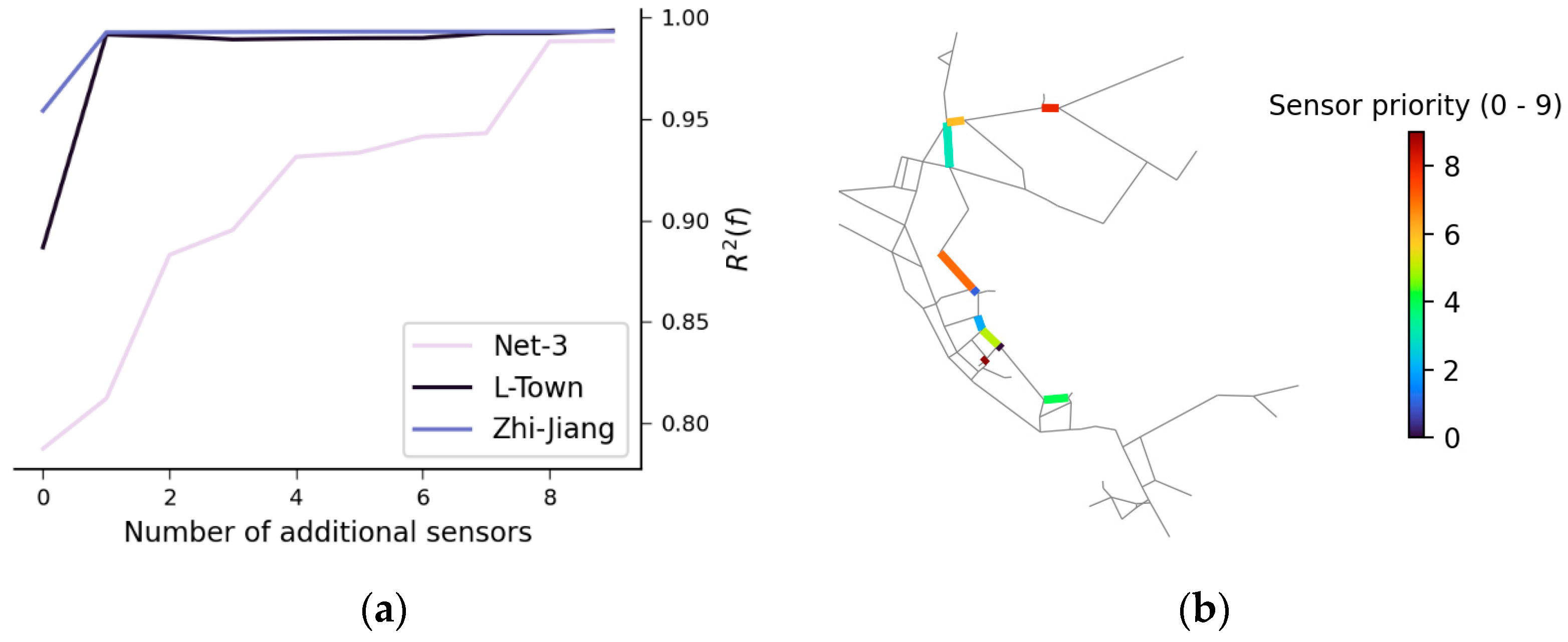Sensor Placement and State Estimation in Water Distribution Systems Using Edge Gaussian Processes †
Abstract
1. Introduction
2. Materials and Methods
2.1. Problem Statement
2.2. Flowrate Estimation with Gaussian Processes
2.2.1. Mass-Conservative Covariance
2.2.2. Virtual Edges
2.3. Sensor Placement
2.4. Evaluation
| Algorithm 1. Sensor Placement Strategy |
| Input: Covariance K, , , for j = 1 to k: Update K according (1) and (2) end |
3. Results
4. Discussion
5. Conclusions
Author Contributions
Funding
Institutional Review Board Statement
Informed Consent Statement
Data Availability Statement
Conflicts of Interest
References
- Kang, D.; Lansey, K. Optimal Meter Placement for Water Distribution System State Estimation. J. Water Resour. Plan. Manag. 2010, 136, 337–347. [Google Scholar] [CrossRef]
- Perelman, L.; Ostfeld, A. Application of Graph Theory to Sensor Placement in Water Distribution Systems. In Proceedings of the World Environmental and Water Resources Congress 2013, Cincinnati, OH, USA, 19–23 May 2013. [Google Scholar]
- Yang, M.; Borovitskiy, V.; Isufi, E. Hodge-Compositional Edge Gaussian Processes. arXiv 2023, arXiv:2310.19450. [Google Scholar]
- Todini, E.; Rossman, L.A. Unified Framework for Deriving Simultaneous Equation Algorithms for Water Distribution Networks. J. Hydraul. Eng. 2013, 139, 511–526. [Google Scholar] [CrossRef]
- Alain, M.; Takao, S.; Paige, B.; Deisenroth, M.P. Gaussian Processes on Cellular Complexes. arXiv 2023, arXiv:2311.01198. [Google Scholar]
- Nguyen, V. Bayesian optimization for accelerating hyper-parameter tuning. In Proceedings of the IEEE 2nd International Conference on Artificial Intelligence and Knowledge Engineering (AIKE 2019), Sardinia, Italy, 3–5 June 2019. [Google Scholar] [CrossRef]
- Dandy, G. 06 Zhi Jiang. Int. Syst. 2016, 6. Available online: https://uknowledge.uky.edu/wdst_international/ (accessed on 7 September 2024).
- Vrachimis, S.G.; Eliades, D.G.; Taormina, R.; Kapelan, Z.; Ostfeld, A.; Liu, S.; Kyriakou, M.; Pavlou, P.; Qiu, M.; Polycarpou, M.M. Battle of the leakage detection and isolation methods. J. Water Resour. Plan. Manag. 2022, 148, 04022068. [Google Scholar] [CrossRef]
- Rossman, L.A. 06 EPANET Net 3. Software Manual Examples. 2016. Available online: https://uknowledge.uky.edu/wdst_manuals/2 (accessed on 7 September 2024).

Disclaimer/Publisher’s Note: The statements, opinions and data contained in all publications are solely those of the individual author(s) and contributor(s) and not of MDPI and/or the editor(s). MDPI and/or the editor(s) disclaim responsibility for any injury to people or property resulting from any ideas, methods, instructions or products referred to in the content. |
© 2024 by the authors. Licensee MDPI, Basel, Switzerland. This article is an open access article distributed under the terms and conditions of the Creative Commons Attribution (CC BY) license (https://creativecommons.org/licenses/by/4.0/).
Share and Cite
Kerimov, B.; Pons, V.; Pritsis, S.; Taormina, R.; Tscheikner-Gratl, F. Sensor Placement and State Estimation in Water Distribution Systems Using Edge Gaussian Processes. Eng. Proc. 2024, 69, 150. https://doi.org/10.3390/engproc2024069150
Kerimov B, Pons V, Pritsis S, Taormina R, Tscheikner-Gratl F. Sensor Placement and State Estimation in Water Distribution Systems Using Edge Gaussian Processes. Engineering Proceedings. 2024; 69(1):150. https://doi.org/10.3390/engproc2024069150
Chicago/Turabian StyleKerimov, Bulat, Vincent Pons, Spyros Pritsis, Riccardo Taormina, and Franz Tscheikner-Gratl. 2024. "Sensor Placement and State Estimation in Water Distribution Systems Using Edge Gaussian Processes" Engineering Proceedings 69, no. 1: 150. https://doi.org/10.3390/engproc2024069150
APA StyleKerimov, B., Pons, V., Pritsis, S., Taormina, R., & Tscheikner-Gratl, F. (2024). Sensor Placement and State Estimation in Water Distribution Systems Using Edge Gaussian Processes. Engineering Proceedings, 69(1), 150. https://doi.org/10.3390/engproc2024069150





